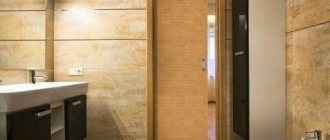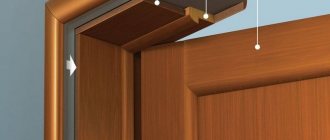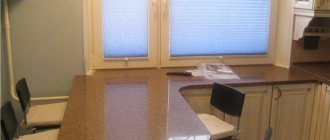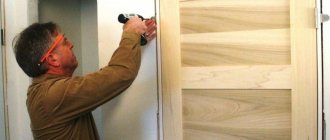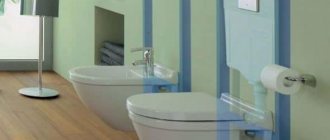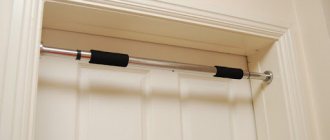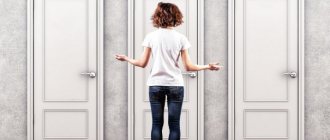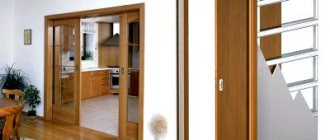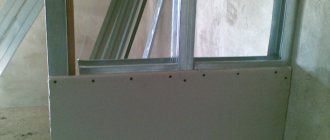What are wardrobe doors made of?
A sliding system usually consists of these components:
- door frame (side pillars + horizontal stripes);
- Filler - door leaf;
- lower and upper rollers;
- Tape stroke;
- Guides.
For a better understanding of the terms and the entire assembly process, you will find a detailed description of each component in the table.
| door frame | |
| Side racks | Duralumin racks have longitudinal slots into which the tape is inserted. From the outside, the profile is made in the shape of a curve, which acts as a handle. The cross-section of the racks may vary, but they all hide a longitudinal groove with a bend. Some side stripes are made solid, and individual handles in the form of shaped plates are attached to them in the middle. |
| Crossbars | Cross beams connect the vertical posts into a single structure - the frame. A pair of vertical rollers are installed inside the lower cross beam. The horizontal bar section and the height of the side walls completely hide the rollers. |
| If the filling consists of several parts, then the central strips are inserted into the frame. They have double-sided slots into which the top and bottom sheets fit. Find out more about profiles for your wardrobe. The products of the Austrian company Stern deserve attention. | |
| Adhesive tape | Self-adhesive elongated tape (also called Schlegel) is designed to perform two functions. The soft texture of the strip dampens the sound of the door adjacent to the side wall of the case. The stack prevents dust from entering the shiforob. On the racks, on the outside of the frame, there are vertical grooves for the damping strip. |
| The door frame can be constructed in the same way as a window frame from a wooden beam. In it, as in a metal frame, make longitudinal grooves along the inner perimeter of the frame with the router. The width of the slots should be equal to the thickness of the filling sheet. | |
| Guide tracks | They have a different cross section. In cross section, both strips resemble the letter “S”. The bottom rail is made with low grooves in the longitudinal direction. This is enough to prevent sideways movement of the wheels. The upper tire has high sidewalls (40 mm) to prevent the upper rollers, and with them the entire gate, from tipping over. Read more about cabinet slides here |
| Filling the door leaf | |
| Mirror | Mirrored cabinet doors create a beautiful furniture façade, visually expand the space and improve room lighting. You can use clear and colored mirrors in silver, bronze, matte and various colors. Their back side is covered with a film that retains fragments in the event of destruction of the door trim. Three techniques are used to decorate mirrors:
|
| MDF and chipboard | MDF can be used to fill entire sliding systems. For compartment doors, use slabs with a thickness of 6 to 10 mm. Their surface can be laser engraved with beautiful patterns. The material is also laminated with PVC film, painted with patterns. Laminated chipboard is cheaper than MDF. On the building materials market you can find laminated chipboards with matte and glossy facades that imitate leather and small wood species. |
| Laminate | Laminated parquet slats can completely replace expensive material for filling sliding doors. It is available in light and dark shades that imitate fine wood species. 10 mm thick parquet fits perfectly with an aluminum door frame. |
| Plywood | Use laminated plywood to assemble a façade on a budget. The material can be easily sawed and sawed with a jigsaw. The filling can be uniform or combined. You can insert fragments of the correct geometric shape or make a shaped combination of MDF or laminated chipboard with a mirror. Aluminum profiles have grooves 10 mm wide. If the filling material is thinner than this dimension, a seal will need to be installed. |
| Upper and lower rollers | |
| Bottom rollers | Fastened with self-tapping screws on both sides inside the horizontal profile of the door frame. The wheels are made of polymer, which ensures silent movement of the door. The sliding assemblies are designed in such a way that when the gate is installed, they are pressed against the bottom bar using springs. This allows the top of the frame to fit into the track. |
| Top rollers | Installed on frame posts on both sides of the door. Unlike the lower wheels, the wheels rotate horizontally and are completely hidden by the high crossmember profile. |
Rear mount
This stage can be considered the final one. The rear wall of the cabinet is usually made of HDF, the thickness of which is from 3 to 4 millimeters. It is fastened with the help of furniture nails, already supplied with the purchase of the cabinet, or special screws of small sizes 4*16 and lining corners. Of course, a more reliable and stronger option is screws with backing corners; they will securely fix the back wall and will not allow it to fail, unlike furniture nails. Therefore, when purchasing a cabinet, you will immediately be sure which components are included in the furniture assembly.
We attach HDF along the entire back of the cabinet body, to its internal partitions and tightly fixed shelves, this will give the back wall greater protection.
You can assemble the back part in the early stages, when the cabinet is still lying down, but it is best to leave it at this stage so as not to spoil the thin wall.
Sash design
The wardrobe door consists of profiles:
- lower;
The lower profile has deeper side walls - upper;
Upper profile for compartment door leaf - profile handles;
The handle can be on both sides - Intermediate.
These profiles are placed between parts of the door leaf, but you can do without them - if the door is solid and not composite.
This entire assembly has the appearance shown in the photograph. In this frame, the door material you choose is inserted into the grooves. It can be glass, mirror, chipboard and other materials.
Hanging structure without filling
Separating profiles are optional. They are necessary if you assemble doors from different materials or simply like them this way. The maximum thickness of the filler is 10 mm, the minimum thickness is 4 mm. Thinner ones - glass, plastic, mirror - are inserted through a gasket.
In order for the gate to move, upper and lower rollers are installed on it. The lower rollers bear the entire weight of the gate, and the upper ones stabilize the vertical position of the gate, preventing its deformation.
Rollers for cabinet doors
The rollers are attached to the side profiles with special fasteners.
Advantages
Such a system has an important advantage over other options: the design takes up minimal space, which significantly saves space. In addition, the use of a sliding wardrobe does not require additional territory, since the doors are opened by moving them in parallel, and there is no need to open them wide open.
As a result, it becomes possible to create a more attractive interior, and the cabinet is very convenient to use. Such furniture can be decorated according to any requirement. The door itself may contain a mirror, it can be supplemented with paintings, beautiful monograms, or an original photo can be applied.
At the same time, the design is relatively inexpensive, and you can save on installation. However, this procedure must be taken with great responsibility, since illiterate actions can lead to misalignment of the doors, for example, and therefore to deterioration in performance, and therefore to a decrease in service life.
Guides for sliding doors
As you can see, fascia isn't everything. You need guides along which the doors will move. There are two of them: upper and lower. They differ significantly in appearance.
Top rail for cabinet doors
Metal bottom rail
When installing the gate, first push it firmly into the top track, lift the gate until it stops and insert the lower rollers into the corresponding groove. The entire structure is shown in the following photo.
Installation diagram
Kinds
There is a classification of sliding doors, thanks to which they are divided into different types. The classification depends on the location and method of installation, design and number of door leaves.
Sliding doors are used in different places. They are installed in doorways in the kitchen, room, toilet or bathroom. With their help, they enclose space, separating one area from another.
Most often, sliding doors at home are installed between two rooms. They can move along the wall and have an open design, or they can be built into a niche and, when opened, completely disappear inside it. The hidden design requires the installation of a frame and other significant repairs that are carried out before installing the door.
The compartment door is also used in closets. Furniture designs have their own specifics. As a rule, such a door moves along two guides and has two pairs of rollers. Some are located at the bottom of the door leaf, and others at the top. Interior compartment doors, unlike furniture options, most often have one guide – the top one. In this design, it performs two functions: holding the door leaf and ensuring movement.
You can install any design in the dressing room. It all depends on the area of the enclosed space and the desires of the owners. The surface of the door leaf in the dressing room is usually mirrored.
Very often, a dressing room or wardrobe may have an irregular shape. Then doors having a non-standard radius shape are installed. Radius doors are characterized by smooth corners and a unique curvature of the door leaf. Fixation and movement of unusual doors is carried out along two guides that have the same curved shape and are installed both in the upper and lower parts.
Materials and sizes
Doors for a cabinet built with your own hands are not as complicated as the owner might think at first glance. However, in this case, preparation is important, which includes the acquisition of all materials and accessories, as well as the selection (calculation) of the dimensions of the compartment doors.
Materials for making doors
This is the first stage that you need to go through if you plan to make furniture with your own hands. There is a choice: you can use several suitable materials to create cabinet doors.
- Chipboard is a traditional candidate. These boards are the most common and convenient material, so they are often purchased for making various furniture. If the master does not yet have experience in this type of work, then chipboard will be the best choice: working with them is relatively easy. The best option is the most secure laminated panels (LDPE).
- MDF. This material is of higher quality, but the price is also less attractive. If you just make the doors out of MDF, you can save some money on cabinet assembly, but the doors will look better.
The last contender is a massive tree. This is the beauty leader on this list, but working with such an expensive material requires a lot of experience. So for beginners, chipboard or MDF is more suitable.
Dimensions
Width is a parameter that depends more on the size of the furniture, but there is no limit. However, there are a number of recommendations for creating a design that will be as convenient and hassle-free as possible.
- The optimal minimum width of one door is 500 mm. Yes, the master can narrow it, but in this case the sheet may become deformed and then simply “slip out” of the guides.
- The maximum recommended width is 1100 mm. But even this size is not the best option, since the owners will have to put in a lot of effort, and for small family members, “filling up” the wardrobe can become an unattainable goal.
If we talk about the recommended sizes in which you will not have any difficulties when operating the “warehouse”, they are in the range from 600 to 900 mm. The width of the furniture affects the number of doors. When the doors are open, they should not block access to the contents of the cabinet.
As for the height of the doors, in this case there are no strict restrictions. This parameter depends on the height of the ceilings or the height of the furniture being installed, so this measure is chosen by the owners themselves.
Opening requirements
They are much stiffer than traditional swinging structures and even stiffer than horizontal surfaces. The original dimensions remain the length of the opening and its height, but the top and bottom edges must be ideal along the entire length.
Small vertical deviations in the side walls will not affect the cabinet doors too much. It is not difficult to cover these imperfections with decorative trim. However, even a small horizontal difference can cause the cabinet doors to gradually come off. The worst-case scenario is that they jam. To avoid such consequences, the top and bottom profiles are often mounted on adjustment bars. The first, “cheapest candidate” is an element made of chipboard.
The width of these strips is selected depending on the system; the standard is 100 mm. If you select this option to compensate for unevenness, the height of the opening is measured after installation is complete. The second method is to subtract their total thickness from the previously measured opening height.
Final work
Now you can begin the final part of the work, namely attaching the buffer tape to the ends of the flaps. It will not allow dust to penetrate into the middle of the cabinet, and will also soften the impact of the doors on the walls each time they close.
The installation of the buffer tape is the final stage. If you do this without first aligning the shutters, then the adjustment will not be possible. You will have to peel off the seal with your own hands, adjust and stick the tape again.
DIY wardrobe doors
Work will continue without delay or pause if everything necessary is prepared in advance. And in this case, the master cannot do without tools. The required set includes:
- hammer (rubber mallet);
- drill, metal chisels;
- sandpaper, folder;
- Punch for fastening profiles to solid walls;
- ruler, angle, plumb line, level (regular or laser);
- Metal hacksaw or electric hacksaw with aluminum hacksaw blade;
- a set of screwdrivers or screwdrivers with bits (standard and hex);
- a hand-held circular saw or an electric jigsaw if you decide to make your own door inserts.
Angle grinders and aluminum do not mix. Cutting with a grinding machine will inevitably lead to overheating and destruction of the structure of the protective coating of the metal. There is an alternative to “working with your hands.” You can take the easy way out and order profile cutting from a company that sells sliding systems.
Filling
After this preparation, begin assembling the fillers. Most often you order door filler. However, sections can be made with your own hands. In this case, the work must be completed flawlessly. The accuracy of marking, observance of right angles, and uniform cutting are extremely important. Otherwise, there will be no guarantee that the elements will fit the finished frame. Incorrectly cut blanks can deform it. Another necessary step is chamfering (depth and width - 2-3 mm).
If the design includes glass or mirror parts, first place a rubber seal around the perimeter. It is placed by pressing a finger into the end of the element. The ends of the sealant are located opposite each other, leaving no overlap. To avoid injury if the element breaks, the protection is glued to the back of the mirror. An ordinary self-adhesive film is suitable for this role. A door consisting of several fragments is assembled using intersecting profiles.
Sometimes it may take considerable force to insert the upholstery. In such cases, the material that will not come out is forced to tap on the back of the hand or with light, gentle blows with a rubber mallet. After the sash is assembled, the final blade profiles are installed equally at the top and bottom.
Framing
Then proceed to installing the side profiles. The steps here are similar to the previous ones: first, the filling is carefully inserted into the groove, using hands or tools, then the section is pushed until it stops, preventing the slightest displacement. After assembly, the frame is tightened using fasteners.
Start at the top of the sashes. Insert the fasteners into the drilled hole, tighten the connection with a hex key. Insert the upper rollers between the profile bridge and the screw head. Then the screw is tightened. Proceed in the same way on the other side of the sheet.
Installation of guides
The dimensions of the slides must correspond to the width of the cabinet. The difference of plus or minus 3 mm is not significant, so a small dimensional error is acceptable. Install the top rail first.
Top guide
Secure the guides with 4.2×16 self-tapping screws or 3.5×16 countersunk screws. Drill a hole in the top rail with a 4mm drill bit. The distance between the holes is approximately 300 mm.
If you need to secure the rail with a countersunk screw, then the holes need to be secured with a 6-8 mm countersunk head. This is to make sure the screw is fully seated, so to speak. So the instructions for installing the top rail are quite simple. Once you've drilled the holes in the rail, you need to insert it, line it up flush, and secure it.
Bottom guide profile
In this case, it is also necessary to drill holes in the profile. But don't rush to attach the bottom rail to the cabinet. The reason for this is that it must be offset within the cabinet by 20mm. In order to achieve an accurate notch, you must first install the bottom rail profile into the cabinet. Next, install the doors to the closet. It is impossible to do without an assistant in this task. The door must be installed strictly vertically. This can be achieved by moving the lower guide profile, checking verticality using a spirit level.
Install the locking device before screwing the bottom rail. The next section describes how to do this correctly.
Sources
- https://remboo.ru/dizajn/mebel/dveri-dlya-shkafa-kupe.html
- https://made-box.ru/samostoyatelno/sborka-dverej-shkafa-kupe-svoimi-rukami.html
- https://stroychik.ru/mebel/dveri-dlya-shkafa-kupe-svoimi-rukami
- https://dom-i-remont.info/posts/mebel/dveri-dlya-shkafa-kupe-svoimi-rukami-sborka-i-montazh-udobnoj-sistemy/
- https://kakpravilnosdelat.ru/ustanovka-dverey-shkafa-kupe-svoimi-rukami/
How do sliding systems work?
The compartment door is designed in such a way that its doors slide apart to the sides. This can be either one or two door leaves, moving parallel to the ceiling or sliding inward. And if the general operating principle of such doors is the same, then the installation and opening methods are different. Let's talk about this in more detail.
Table No. 1. Main types of sliding systems.
| View | Description |
| Mounted | In this case, the canvas is fixed on guides - on the ceiling or directly above the opening. This way the doors will move along the wall with a slight indentation from it. It is not recommended to install furniture or any other objects near the door - they will be an obstacle to the door panels. |
| Hanging | In this case, the door leaf is fixed to the cut of the opening. Accordingly, the door moves close to the wall, which looks more neat and aesthetically pleasing. Hanging doors allow you to place pieces of furniture next to the opening - they won’t get in the way. |
Table No. 2. Types of interior sliding doors by opening method
| View, illustration | Description |
| Coupe | This is the most primitive version of sliding doors, so even an inexperienced person can handle the manufacture of such a model. The design comes with either one or two panels. |
| Radial | The movement of the canvas does not occur along a smooth guide, but along a circle. This option is ideal for rooms with curved ceilings and is good for corner cabinets. The design has a very original appearance, but not every person can handle its manufacture. |
| Cassette | They also come with one or two doors and move in different directions according to the same principle as sliding doors. The difference is that they slide into special recesses in the wall, which makes this design very convenient, because you can place furniture near the wall without any problems. Of course, making such a door will be a little more difficult, because you will have to provide for a niche in the ceiling. |
| Telescopic | The design is designed in such a way that a separate guide is fixed for each blade. Such doors are often installed as interior partitions and for decoration. They can be assembled in a single part of the opening - just pull one panel by the edge, and the others will follow it. Of course, this is also a rather complex system, just like the radius, so it’s not easy to make. |
| Intra-opening | The canvases are fixed in the opening and move towards each other. The design assumes the ability to open only one half of the opening. However, you can place various objects against the walls that will definitely not interfere with the opening of the doors. |
| Harmonic | This is a very simple hinged door design. The canvas moves on rollers attached to the top. The disadvantages include not the best sound insulation. |
Design diagram with top movement mechanism
